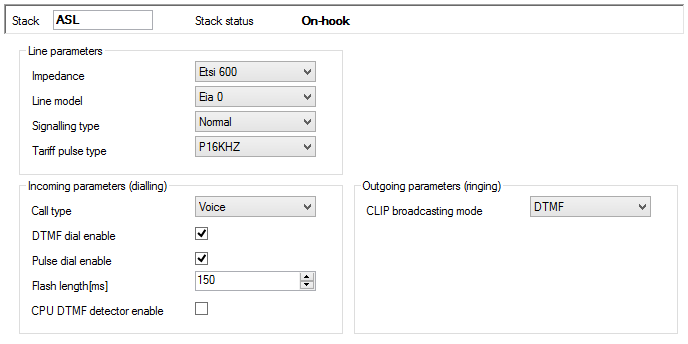3.3 ASL
The ASL virtual port is used for connecting common analogue telephones or fax machines. This virtual port enables DTMF and pulse dialling detection and as well as DTMF or FSK using CLIP transmission. The parameters are divided into logical sections.
Stack status
This field displays information on the stack and its current status. With an ASL virtual port you can see the following statuses:
- null
- config
- on_hook
- off_hook
- error_stop
- error_start_req
Figure: View of ASL Virtual Port Hardware Configuration
Line parameters
- Impedance – this parameter determines the impedance of the hybrid circuit according to preset models (User, ETSI 600, Germany and Real 600).
- Line model – this parameter provides further hybrid circuit parameters according to preset models EIA0 to EIA7 (e.g. EIA0 represents a 100m long line model).
- Signalling type – shows the type of active state signalling. Choose from Reverse polarity, Tariff pulse or Simple.
- Tariff pulse type – defines the tariff pulse sending source. Select 12 kHz, 16 kHz or none.
Incoming parameters (phone is dialling)
- Call type – determine the preferred type of communication on this port. Choose one of the Voice, FAX, A3.1kHz Audio and 56kb Modem options.
- DTMF dial enabled – make the carrier detect DTMF dialling from an analogue phone.
- Pulse dial enabled – make the carrier detect pulse dialling from an analogue phone.
- FLASH length [ms] – set the maximum time of the FLASH signal transmitted from a local phone to the PBX. The default value is 150 ms and the minimum value is 80 ms.
- CPU DTMF detector enable – disable/enable DTMF detection using a detector on the board in order to save the internal PBX detectors.
Outgoing parameters (phone is ringing)
- CLI broadcasting mode – define the preferred CLIP (Calling Line Identification Presentation) transmission type. The selections are DTMF, FSK and none.

